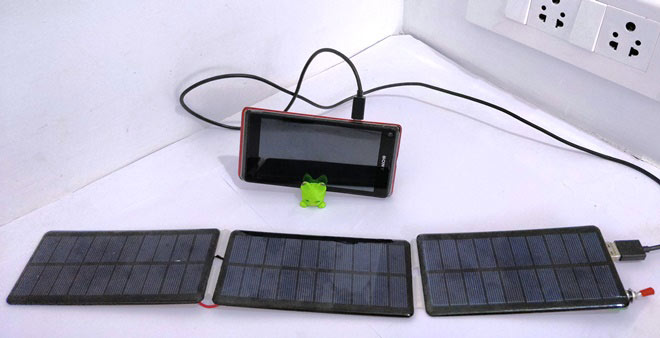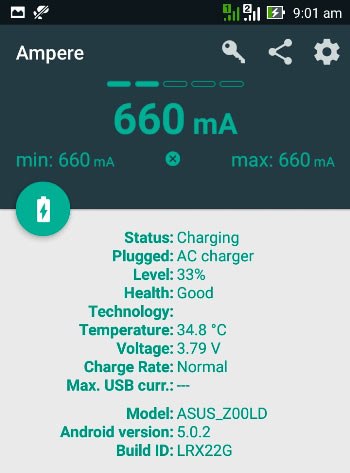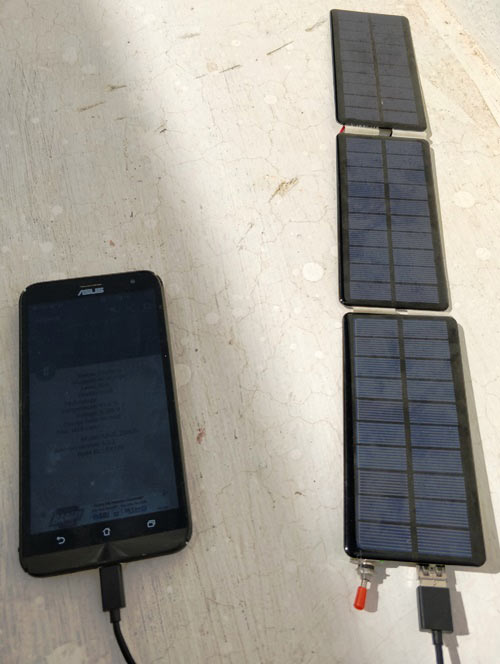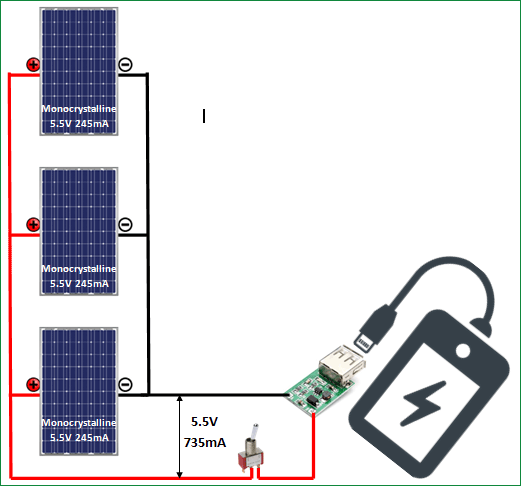
Electronic gadgets like Mobile Phones and IPods have made our lives a lot easier. But, all of them suffer from one common drawback of charging them at regular periodic intervals. This becomes a problem when we are traveling or at a place where electricity is not available. Also using renewable energy source is quoted as the next generation fuel for all our electricity requirements.
So, in this project let us learn how easy it is to Make Our Own Solar Cell Phone Charger and also how it works.
Materials Required:
- Solar panel 5.5V 245mA (3 Nos)
- 5V Boost converter module
- Switch
- Masking Tapes
- Wires
- Soldering kit

Working Explanation:
The Primary principle of this project is to convert solar energy into electrical energy. To accomplish this we just need a solar panel, but there are lots of types and ratings in solar panel to select from. Monocrystalline, Polycrystalline and Amorphous are the three types of solar panels in which we will be using the Monocrystalline one, since it is commonly available and cheaper than the other two.
In order to decide the voltage and the current rating of our panels we have to consider the voltage and current that would be consumed by the load. In our case the load is the mobile and it requires about 5V and 1A to get charged in its maximum efficiency. Since providing 1A and 5V using solar panel would make the project bulkier and expensive, we decided to design the system for more than 70% efficiency. Thus, we have selected the 5.5V 245mA solar panels. We will be using three of these panels which will be connected in parallel, as we all know connecting it in parallel will keep its voltage constant and sum up the current rating. Hence, the final voltage and current rating of all the three modules will be 5.5V and 735mA (245+245+245). The rating of a single panel is given in the table below
|
Solar Panel Details |
|
|
Type |
Monocrystalline |
|
Output Voltage |
5.5V |
|
Output Current |
245mA |
|
Power rating |
1.2 Watt |
|
Dimension (L*H*B) |
130mm * 64mm * 2.5mm |
As we all know the output voltage and the current supplied from the panel directly depends on the solar radiation that falls on the panel. This makes it clear that our panel will not provide 5.5V and 735mA all the time. So we need something that could boost and regulate the voltage to 5V all the times irrespective of the radiation. This is where we will be suing the 5V Boost converter from which we directly power our phone. The details of the Booster Module is given below:
|
DC-DC Booster Details |
|
|
Type |
Boost Converter |
|
Output Voltage |
5.1-5.2 V |
|
Operating Input Voltage |
2.7V-5V |
|
Output Current |
1.5A (Maximum) |
|
Efficiency |
96% |
|
Load Regulation |
1% |
Here we can also use Solar Tracker Circuit so that sun light can fall on the panels all the day.
Circuit Diagram:
Circuit Diagram of Cell Phone Solar Charger is given below:
As shown in the above wiring diagram simply solder the solar panel in parallel and connect them to a boost converter module through a switch. Now simply use any power cable and connect it to the USB pin of the module and the other end to your Mobile phone. When there is proper radiation the phone will start to get charge.
Testing the Solar Cell Phone Charger:
The performance of the charger depends on the amount of current it could deliver to charge the phone. This will help us in charging the phone as soon as possible. To know this we used an Android App called “Ampere” (Downloaded from play Store). This app will let us know how much current is drawn by the battery for charging. We first connect the phone to a normal Charger (AC mains) and found that my phone (Asus Zenfone) requires about 1000mA for charging as shown in the screen shot below.

Later I connected the phone to our solar charger and measured the current to be around 700mA which is pretty much close to the actual charging current. This will help you to charge the phone quickly even when charging through solar energy.


The complete working is shown in the video below. Hope you enjoyed the project and planning to build your own. If you have any doubts post them on the comment section below. Also check our previous Cell Phone Charger Circuit.
Comments
Great! Let us know once you
Great! Let us know once you finish it eager to see what you build!
Need of blocking diode.
I want to know , whether this circuit will require blocking diodes ?
Its optional, however using
Its optional, however using one would be a good practise
hey, do you know what kind of
hey, do you know what kind of diode one should put in the circuit ? i have a hard time figuring this out
any help appreciated







Good its easy i try my best to follow it and introduce unique solar charger